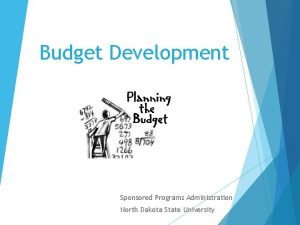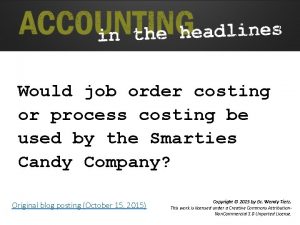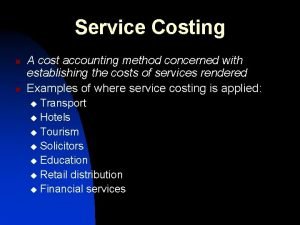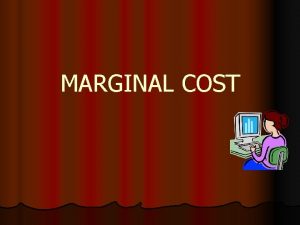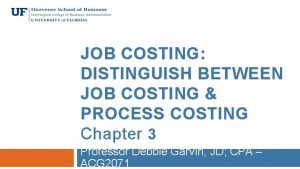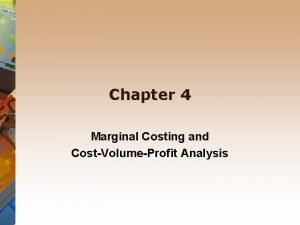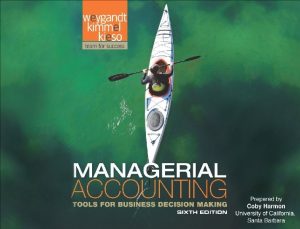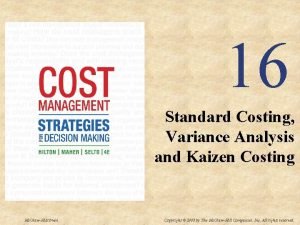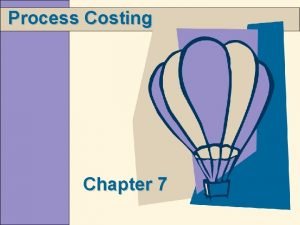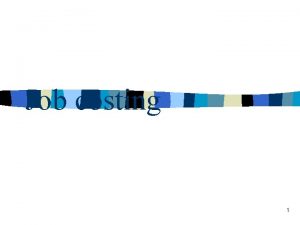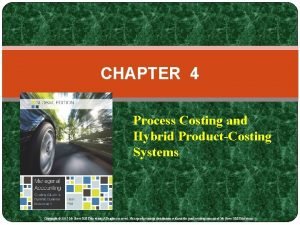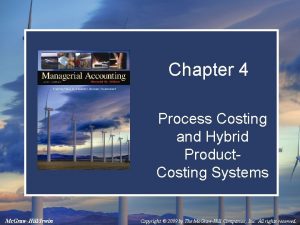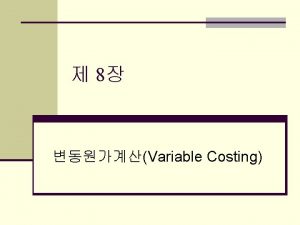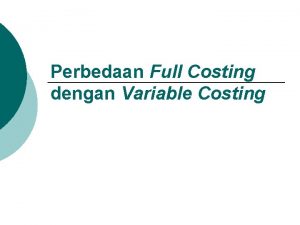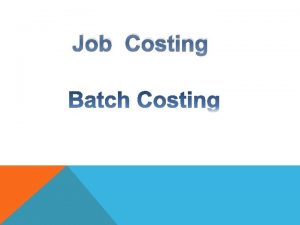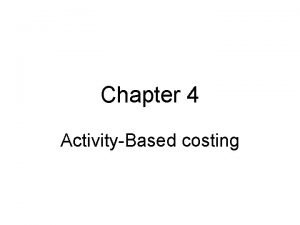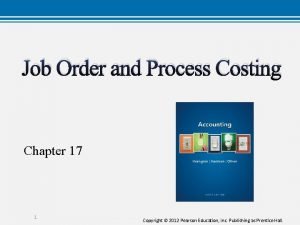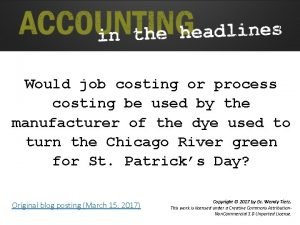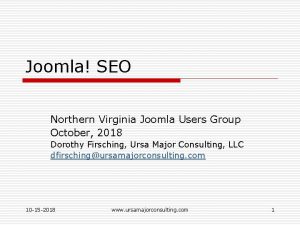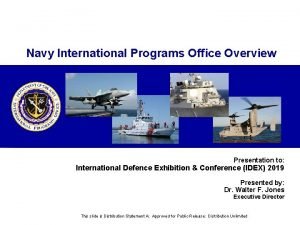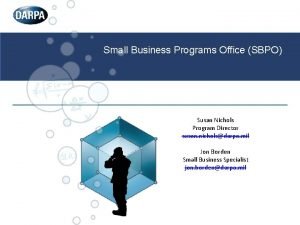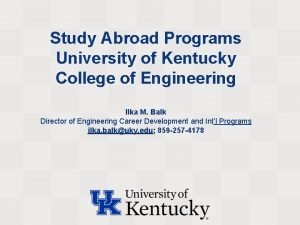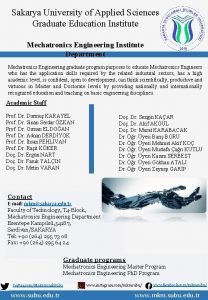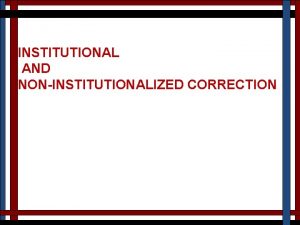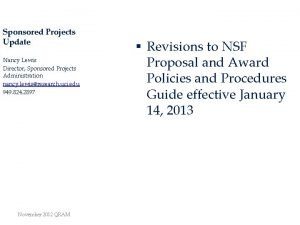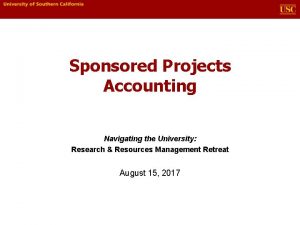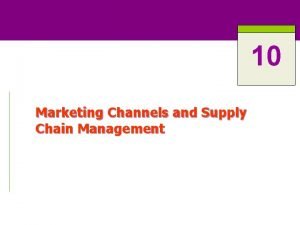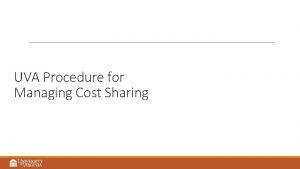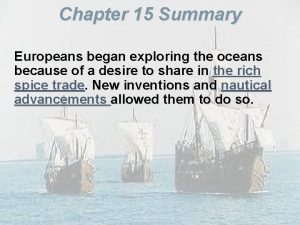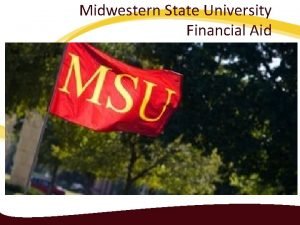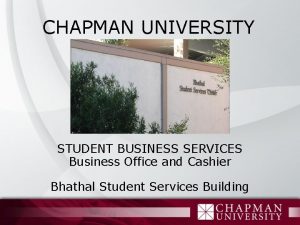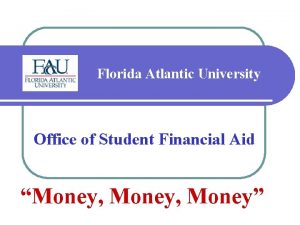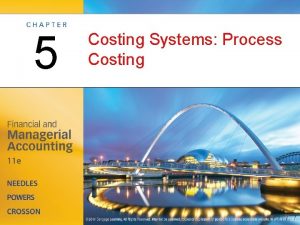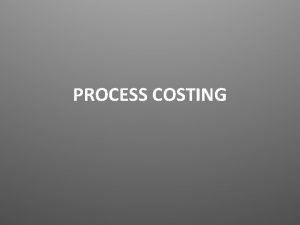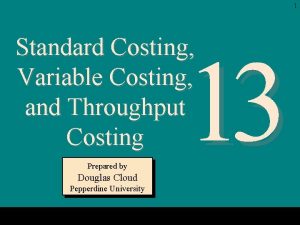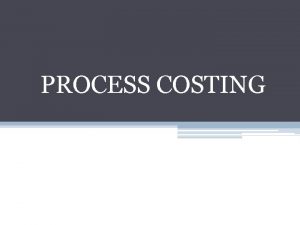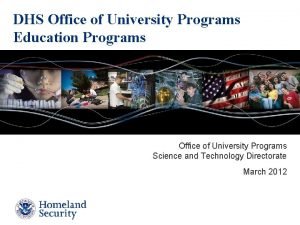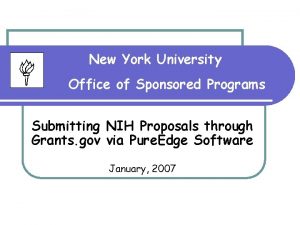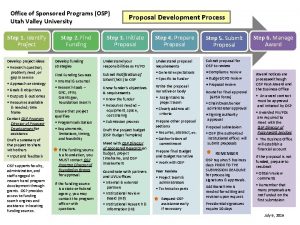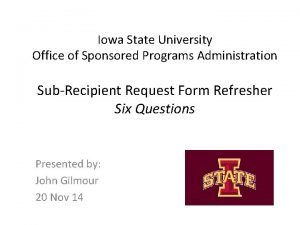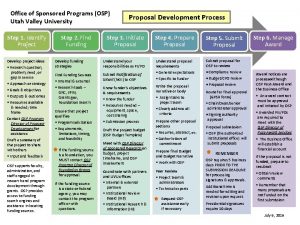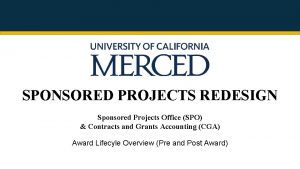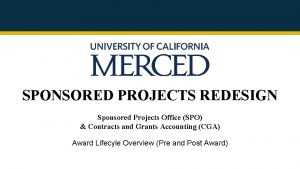Office of Sponsored Programs University of Virginia Costing






























































- Slides: 62

Office of Sponsored Programs University of Virginia

Costing Basics Pre-Session Discussion and Our Learning Objectives § When you hear ‘Costing’…what do you think of? § What makes a cost ‘allowable’ to a sponsored project? § What makes that same allowable cost – ‘allocable’ to a sponsored project? § What is the name of the costing circular for Educational Institutions on which we base our costing practices and decisions? § Give some examples of Direct costs. § Give some examples of Facilities & Administrative (F&A)/Indirect costs

Costing Basics Pre-Session Discussion and Our Learning Objectives § What makes Direct and F&A cost different? § Do you know how the institution arrives at the F&A rates? § Are you familiar with Transaction Controls and how they are managed? § What is Cost Share? § What do you consider in selecting an Expenditure Type to charge? § Can you converse comfortably with your faculty/staff on costing matters?

Costing Basics Federal Costing Requirements: Don’t charge the Government twice for the same cost. (Direct Costs versus Facilities & Administrative Costs) F&A Costs = The Cost of Doing Business Don’t charge the government for any expressly ‘unallowable’ costs. Be CONSISTENT in the budgeting, charging and reporting of costs on Federally sponsored awards-this consistency must be achieved across grounds Office of Sponsored Programs University of Virginia

Costing Basics CAS: Four Standards CURRENTLY Applicable to Educational Institutions Receiving $50 M or More in Federal Awards Standard #501 (48 CFR 9905. 501): Requires consistency in estimating, accumulating and reporting costs by educational institutions Standard #502 (48 CFR 9905. 502): Requires consistency in allocating costs incurred for the same purpose by educational institutions (either as direct or as F&A costs) Standard #505 (48 CFR 9905. 505): Requires accounting for unallowable costs Standard #506 (48 CFR 9905. 506): Defines the Cost Accounting Period Office of Sponsored Programs University of Virginia

Costing Basics Applying Costing Requirements at UVa. APPLIES TO ANY SPONSORED AWARD SATISFYING ANY 1 OF THE FOLLOWING CRITERIA: Federally funded Funds used as cost sharing Federal Flow through Funding Proposal or award terms/conditions reference 2 CFR 200 Office of Sponsored Programs University of Virginia

WHEN DO I NEED A COSTING EXCEPTION FORM? . . is normally considered part of F&A (overhead) -and/or- . . falls under an expenditure type that is “locked” by Transaction Controls -and/or. . is NOT Transaction-Controlled, but still needs approval: • General Use Software • General/Administrative Salaries Office of Sponsored Programs University of Virginia

Costing Basics Is The Funding Federal/Flow-Through? Award documentation contains the name of the Sponsoring entity (Take care here…. Words like national or American don’t always denote a federal funding agency) Award documentation references a (Catalog of Federal Domestic Assistance (CFDA) number. A number assigned to Federal programs signifying the Sponsoring agency and the program being funded. Contracts received as direct Federal awards or via Flow-Through funding Award documentation references 2 CFR 200 Office of Sponsored Programs University of Virginia

Costing Basics UVA Costing and Costing Specific Documents POLICIES VIII. C. 1 Compliance with Sponsor Requirements PROCEDURE OSP - Budgeting Direct Costs of Sponsored Programs

Costing Basics The University’s Disclosure Statement (DS-2) CAS requires that the institution DISCLOSE. . . our “costing practices” formally in the Disclosure Statement or “DS-2” document & FOLLOW. . . the practices that we have disclosed in the DS-2!

Costing Basics CAS: The University’s Disclosure Statement (DS-2) The DS-2 describes to the government how we’re treating costs at the University: . . detailing which costs we treat (“allocate”, “assign” or “charge”) as DIRECT COSTS …which ones we treat as FACILITIES & ADMINISTRATIVE (F&A) COSTS. No two disclosure statements are alike!

Costing Basics Talking the Same Language – Key Terms and Concepts

Costing Basics Allowable Costs There are 2 ways to budget, charge, and report “allowable” costs: • Direct Costs • Facilities and Administrative (F&A) Costs Office of Sponsored Programs University of Virginia

Costing Basics Definition: Direct Costs budgeted/charged to specific direct cost categories allocable and identifiable to a single project reasonably supports the technical goals/objectives/outcomes of the project identification is made with relative ease and a high degree of accuracy examples include: PI and research assistant salary, travel, equipment, subcontractors, lab supplies, etc. Office of Sponsored Programs University of Virginia

Costing Basics Definition: F&A Costs budgeted/charged to F&A cost category benefit common objectives cannot be allocated to a single project with relative ease and a high degree of accuracy included in the University’s F&A cost rate proposal and negotiation examples include: utilities, building maintenance, landscaping, payroll, procurement and other central office salaries, the Sticky 6, etc. Office of Sponsored Programs University of Virginia

Costing Basics To be considered DIRECT the cost must be: Allowable - A cost must be allowable under both the provisions of 2 CFR 200. Subpart E (Uniform Guidance), AND the terms of the particular award. (2 CFR 200. 403) Allocable - The project which pays the expense must directly benefit from it. [The item charged to a grant must be directly related to the objectives of the science. ] (2 CFR 200. 405) Reasonable - An expense must be reasonable, in that a “prudent person” would have paid the stated amount for the good/service and also would have budget/charged the cost to a sponsored award in the same manner (2 CFR 200. 404). Consistent - All costs incurred for the same purpose, in like circumstances, are either to be treated as direct OR F&A (indirect) costs (2 CFR 200. 412). Office of Sponsored Programs University of Virginia

Costing Basics Allocation-When is it okay to directly charge a federal award for a given cost item? ØDefinition of a Direct cost must be met ØCost furthers the PURPOSE of the technical aims of the project – are not a general NEED ØCost is adequately documented: NO documentation – NO cost! ØCost/Benefit is clear to a prudent person ØHave a method for allocation decisions Allocation is not always 100% of the total cost or nothing! Some Good Examples: General Lab Supplies Animal Charges Lab Chemicals and Gases Equipment Maintenance/Service Agreements Office of Sponsored Programs University of Virginia

Costing Basics Other Cost Allocation Pitfalls § Charge costs near the end of the project’s life (last 3 months) § Charge the project that has the greater available balance – not alone a reasonable basis for allocation § Charge the project that was funded for more $$ than another was § Charge a project for 100% of the cost when 100% of the benefit was not received – It’s just easier § Charge the problem that is ending the soonest § Charge the project that was most recently received § Charge federal funds first § Perform cost transfers or labor distribution adjustments to fix an allocation (Example, largest NIH project assigned with entire initial cost and later transferring portions onto other sponsored projects)

Costing Basics Costing Decisions & Transaction Controls

Costing Basics Costing Decisions & Transaction Controls This system functionality is intended to aid compliance efforts by restricting the use of certain expenditure types on specific sponsored projects. Transaction controls are established at the PROJECT level. Transaction controls are routinely updated given new expenditure types and costing concerns. Can be “Exclusive” (what you seen in Oracle is what is EXCLUDED from charging) or “Inclusive” (what you see in Oracle is the ONLY thing you can charge) Office of Sponsored Programs University of Virginia

Costing Basics Transaction Controls-What They Are, What They Are Not They Are: • • • In place to assist with institutional costing consistency and our decisions Enabled or ‘locked’ to restrict specific expenditure types from charging to sponsored projects. These select expenditure types carry risks with allowability as direct costs and/or carry risk in their allocation. Established at the project level at the time of PTAO set-up as determined by the type of funding received. Office of Sponsored Programs University of Virginia

Costing Basics Transaction Controls-What They Are, What They Are Not: The only determinate in considering costing decisions. • • Just because a transaction control is “unlocked” doesn’t mean a particular item can be charged to that expenditure type! All costs – regardless of whether transaction controlled or not – need careful decision making before allocating them to a project! Office of Sponsored Programs University of Virginia

Costing Basics Management of A Sponsored Project Transaction Controls The following transaction control ‘templates’ are in use: ü Federal Grants, Contracts, Cooperative Agreements, Clinical Trials (including Federal flow-through awards) – Exclusive Control ü Federal Training Grants and Fellowships – Exclusive Control ü Subcontracts – Inclusive Control ü Non-Federal Awards – Exclusive Control ü Patient Care Projects – Inclusive Control Exclusive – all expenditure types EXCEPT those listed in the template are allowable. “if you see it, you can’t charge it!” Inclusive – ONLY the expenditure types listed in the template are allowable “if you see it, you can ONLY charge it” Office of Sponsored Programs University of Virginia

Costing Basics Costing Decisions & Transaction Controls HOW DO I KNOW IF I HAVE TRANSACTION CONTROLS? Office of Sponsored Programs University of Virginia

Costing Basics UNLOCKING TRANSACTION CONTROLS In order to lift or “Unlock” a Transaction Control a supporting Federal Costing Exception Request form must be submitted and approved. This form provides a justification for costing exceptions and differences by specific project (PTAO).

Costing Basics UNLOCKING TRANSACTION CONTROLS WHEN & HOW DO I SUBMIT THE FCE FORM? WHEN. . an award is made. . you realize you need to purchase an FCE item not previously budgeted HOW Review the OSP NOA and project budget for Costing Exception items – INCLUDING THOSE THAT ARE NOT TRANSACTION CONTROLLED Complete the Federal Costing Exception Form l Obtain all signatures Submit to ospnoa@virginia. edu

Costing Basics UNLOCKING TRANSACTION CONTROLS Caution: Just because an expenditure type is unlocked, doesn’t mean FCE forms are not required for subsequent purchases! We do not “re-lock” every expenditure type after FCE-approved purchases made • Example – A department submits a FCER form for 8 desktop computers that is approved. Later on, they realize they need 2 ADDITIONAL computers. A FCER form is required for these additional purchases, EVEN THOUGH the expenditure type is already open. For items that do not have individually identifiable unit costs, such as Office Supplies, look at the overall comprehensiveness of the charges. • Example – A department gets a FCE form approved for $5, 000 in office supplies required to compile training binders for educators out in the public schools. After the project begins, a determination is made that additional content needs to be added to the binders and there will be an additional $3, 000 in office supplies required. A FCE form would be needed. Office of Sponsored Programs University of Virginia

Costing Basics http: / /www . virgin ia. edu /spon s oredp rogra ms/co mplia nce/c ostac c ountin g. htm l

Costing Basics These are six cost items that are not normally allowable as a direct costs on federal/federal flow-through projects Clerical/ Administrative Salaries Office Supplies Postage Professional Memberships/ Subscriptions Communication Costs (including cell phones, pagers, etc. ) Computers, general use software, and related charges (These are just examples of the many items that are normally considered F&A charges. Visit the Costing guidance web page for more information) Office of Sponsored Programs University of Virginia

Costing Basics Nonsponsored allocation typically required What about printers, etc. ? Allocation of mobile units (e. g. , laptops, I -pads) Generally, you will need to split the allocation with nonsponsored funds to cover possible general use (email, personal use, student use, presence of any general use software, proposal writing, etc). Mobile units are especially risky - vast majority of circumstances will require less than 100% allocation to the project. Printers, cables, memory sticks and the like are RARELY approved for direct charging. 2 CFR 200. 453(c) In the specific case of computing devices, charging as direct costs is allowable for devices that are essential and allocable, but not solely dedicated, to the performance of a Federal award. What about peripherals (monitor, keyboard, etc. )? When is 100% allocation appropriate? Documenting quantities is critical. 100% allocation to federally sponsored project(s) may be appropriate if a computer is required to run a piece of equipment, processing data 24/7, etc. Example: department is purchasing CPU (no monitor) for computer to run equipment in a lab. Allocation of approved peripherals (e. g. , monitors, keyboards, etc. ) should follow the percentage allocation of the approved computer they are tied to. Total purchased quantities throughout the life of the project should equal the number requested on FCER form(s). Any time you purchase more units than were previously approved, a new FCER form will be needed Office of Sponsored Programs University of Virginia

Costing Basics Software Type Examples Transaction Controlled CAS form needed? General Purpose • • No YES – general purpose software is considered part of F&A (overhead) and requires justification for direct charging No No • • • Technical Software Microsoft Office Adobe Illustrator, Acrobat, etc. End Note Snag-It Others • Software required to run technical equipment • Specialized software that is clearly technical in nature (for example, mouse colony management software) Office of Sponsored Programs University of Virginia

Costing Basics § They are transaction- controlled (FCER required to unlock “Supplies, Office”) sharpies § To allow direct charging, must demonstrate unusual circumstance & be a large amount relative to regular use (see unlike circumstances/major projects) sticky notes § Paper, toner cartridges and printer ink are unlikely to receive FCER approval for direct charging. printer ink staples paper toner cartridges binders Many more! Office of Sponsored Programs University of Virginia

Costing Basics Key Terms/Concepts: Expressly Unallowable Costs which cannot be proven to be necessary, reasonable, allocable and thus, the federal government will not cover/reimburse, either as a direct or as an F&A cost. Alcoholic beverages Entertainment (lab gatherings, non-technical meetings) Fines/penalties/fees (late payments to vendors) lobbying losses on other sponsored projects memberships in civic, community organizations and country clubs Office of Sponsored Programs University of Virginia public relations

Costing Basics Why Is Selecting the Right Expenditure Type So Important? üBudgets were formulated based on specific types of costs üBudgets were approved for those specific costs üFinancial reporting often requires detailed cost breakdowns üReduces audit findings If it’s a duck – call it a duck!

Costing Basics More On Facilities & Administrative Costs (F&A) These costs are: not charged directly to Federal or Federal flow-through sponsored awards – cannot meet the direct cost definition not a ‘tax’ assessed to sponsored research awards based on real expenditures previously incurred across grounds in support of research activities represent partial recovery of costs already incurred by the University The recoveries of F&A costs are distributed based on a formula established and reviewed by the Academic Vice Presidents Office of Sponsored Programs University of Virginia

What is the F&A Cost Rate? § A single number that reimburses the institution for the use of: - Buildings Equipment Interest on Debt O&M General Administration Departmental Administration Sponsored Projects Administration Library F&A Slides Courtesy Caroline Beeman UVA Cost Analysis Office of Sponsored Programs University of Virginia

…or stated another way… § The ratio, expressed as a percentage, of an OR facilities and administrative cost pool and an OR direct cost base. § The OR cost pool is made up of allocations from the administrative and facilities cost pools § OR pool costs / OR base direct costs = OR F&A rate. (OR=Organized Research) Office of Sponsored Programs University of Virginia

Calculation of the Facilities & Administrative Cost Rate (aka = Indirect Cost Rate) F&A COSTS § Building Depreciation § Equipment Depreciation § Interest on Debt § Operations & Maintenance § Library Support § General Administration § Departmental Administration § Sponsored Project Administration $88, 160, 000 DIRECT COSTS § Research Salaries & Fringes § Consultant Services § Travel § Technical Services § Research Supplies § Subcontracts up to $25, 000 § Committed Cost Sharing F&A Costs ÷ Direct Costs $152, 000 0. 58 = 58% F&A Slides Courtesy UVA Cost Analysis Office of Sponsored Programs University of Virginia

The F&A Rate Calculation Process Audited Financial Statements MTDC Exclusions: Capital Expenses Subcontracts >$25 k Scholarships/Fellowships Patient Care Costs Tuition Expenses Rental Costs Other Exclusions: Cost of Goods Sold Total Costs Adjustments & transfers F&A Costs Pools: Depreciation Operations & Maintenance General Administration Departmental Administration Sponsored Program Admin. Library Student Admin. & Services Review for Unallowable Expenses Applicable Credits Assign Expenses to F&A Pools and Direct Bases Allocations F&A Costs Major Functions Direct Cost Bases: Instruction and Dept. Research Organized Research Other Sponsored Activities Other Institutional Activities Other Special Direct Bases Distribution Base X Instruction & Department Research XX X Organizes Research XX X Other Sponsored Activities XX X Other Institutional Activities XX F&A Slides Courtesy UVA Cost Analysis

UVA Financial Planning And Analysis https: //financialplanning. vpfinance. virginia. edu/installments-and-distributions Office of Sponsored Programs University of Virginia

Costing Basics Direct Charging of Items That Are Normally Considered F&A When Circumstances are Not ‘Like’

Costing Basics CAS ‘Unlike Circumstances’ – Position that an F&A Cost Will Be Charged Directly Remember this? Ø Must satisfy the definition of a DIRECT COST: ØKEY: allocable and identifiable with relative ease & high degree of accuracy ØFor clerical/admin salaries – work should typically be ‘extensive’ in nature (over and above routine support by the academic unit) ØAlign with the funded purpose of the award to ensure that its goals are unlike those generally charged as F&A costs Office of Sponsored Programs University of Virginia

Costing Basics Adequacy in the Justification of ‘Unlike Circumstances’ Always include the following information on the FCER Form: üspecific cost item(s) ücomprehensive justification, addressing extensiveness and PURPOSE üestimated item quantity and unit cost üProject/Task/Award information üPrincipal Investigator’s last name Office of Sponsored Programs University of Virginia

Costing Basics Direct Charging of Items That Are Normally Considered F&A When Circumstances are Not ‘Like’ Clerical/Administrative Salaries 2 CFR 200. 413 Four conditions under which direct charging of such salaries are allowable: 1) Administrative or clerical services are integral to a project/activity 2) Individuals involved can be specifically identified with the project/activity 3) The costs are explicitly included in the budget or have prior written approval of the federal agency 4) The costs are not also recovered as indirect cost Office of Sponsored Programs University of Virginia

Costing Basics ADMINISTRATIVE – CLERICAL STAFF SALARIES: EXHIBIT C #1 • Large, complex programs Includes General Clinical Research and Primate Centers, Program Projects, environmental and engineering research centers and other grants and contracts that entail assembling and managing teams of investigators from other organizations

Costing Basics ADMINISTRATIVE – CLERICAL STAFF SALARIES: EXHIBIT C #2 • Projects that are geographically inaccessible to routine support, i. e. , research vessels, radio astronomy projects, other remote field locations

Costing Basics ADMINISTRATIVE – CLERICAL STAFF SALARIES: EXHIBIT C #3 Projects that require a large number of repeated travel and/ or meeting arrangements for large numbers of participants, such as conferences and seminars

Costing Basics ADMINISTRATIVE – CLERICAL STAFF SALARIES: EXHIBIT C #4 • Projects involving extensive data accumulation, analysis and entry, surveying, tabulation, and cataloging

Costing Basics ADMINISTRATIVE – CLERICAL STAFF SALARIES: EXHIBIT C #5 Projects funded to produce large numbers of reports, manuals, books, and monographs (excluding routine progress and technical reporting)

Costing Basics Insufficient F&A cost recovery funds to support cost Sponsor won’t pay F&A costs We are the sub and the prime allowed it (e. g. State projects) “But the sponsor approved it” Sponsor is willing to pay questioned costs as direct We did it that way before! Office of Sponsored Programs University of Virginia

What is Cost Sharing? • • Cost Sharing represents the sponsored project costs (direct and indirect) that would normally be borne by the sponsor, but instead are covered by the institution or a third party, such as a subcontractor Types of cost sharing - Mandatory-Required by the sponsor & an award condition included in the solicitation; a binding commitment - Voluntary Committed-Not required by the sponsor, but PI offers quantifiable institutional resources in the proposal; when awarded, becomes a binding commitment - Voluntary Uncommitted - Institution supports research costs, which are not included or quantified in the proposal; when awarded, does not become a binding commitment - Over-the-cap commitments (e. g. , NIH salary cap)-statutory requirements Office of Sponsored Programs University of Virginia

Award with Cost Sharing – Now What? • • Cost sharing commitment entered in Oracle, with appropriate cost share code Cost share codes used at UVA: § 0 -Salary/effort; 2 - No cost sharing; 3 -OTPS; 4 -OTPS and Salary; 5 -MTDC exclusions; 6 -Waived indirect costs; 7 -Third party external; 8 -External sub; 9 External sub and UVA Cost sharing funding source/s re-confirmed at the Award acceptance stage Important to remember that, cost shared expenditure are… Ø Subject to federal cost principles Ø Subject to audit Ø Easily identifiable for F&A rate proposal Ø Part of the official record (record retention) 53 Office of Sponsored Programs University of Virginia

Cost Sharing Funding Source-Cash Institution funds Program income, waived F&A Cash Gift Nonfederal Grant 54 Office of Sponsored Programs University of Virginia

Cost Sharing Funding Source-Non Cash Subawardee cost sharing Donated property, certification for the value of donation Unfunded effort of key personnel – from collaborators 55 Office of Sponsored Programs University of Virginia

Cost Sharing Funding Source-Non Cash Sub-awardee cost sharing • request sub-awardee to submit periodic cost sharing reports • Sub-awardee invoices should reflect inception to date cost shared amounts Donated property • Document value of the donation Unfunded collaborators • request cost share certified quantifying amounts 56 Office of Sponsored Programs University of Virginia

Impact of Cost Sharing on Facilities & Administrative Cost Rate No Cost Sharing F&A COSTS • Building Depreciation • Equipment Depreciation • Interest on Debt • Operations & Maintenance • Library Support • General Administration • Departmental Administration • Sponsored Project Administration $69, 540, 000 DIRECT COSTS • Research Salaries & Fringes • Consultant Services • Travel • Technical Services • Research Supplies • Subcontracts up to $25, 000 F&A Costs ÷ Direct Costs $114, 000 0. 61 = 61% Office of Sponsored Programs University of Virginia

Impact of Cost Sharing on Facilities & Administrative Cost Rate With Cost Sharing F&A COSTS • Building Depreciation • Equipment Depreciation • Interest on Debt • Operations & Maintenance • Library Support • General Administration • Departmental Administration • Sponsored Project Administration $69, 540, 000 DIRECT COSTS • Research Salaries & Fringes • Consultant Services • Travel • Technical Services • Research Supplies • Subcontracts up to $25, 000 • Cost Sharing $1. 5 M F&A Costs ÷ Direct Costs $115, 500, 000 0. 60 = 60% Office of Sponsored Programs University of Virginia

Cost Sharing Companion Account Structure 59 Office of Sponsored Programs University of Virginia

Costing Basics A Few Examples of Cost Share § Commitments of Faculty effort not supported by the Sponsor’s award, or re-budgeting of Sponsor supported salary/effort into other costs categories § Faculty salaries above the ‘salary cap’ – imposed by the National Institutes of Health –cannot be used as cost sharing, but included in the OR base § Travel, supplies, equipment costs not supported by the Sponsor’s award § Project deficits/cost-overruns Example: A university receives a grant for a project estimated to have a total cost of $100, 000. The sponsor agrees to pay 75% ($75, 000) and the university agrees to pay 25% ($25, 000). The $25, 000 is the committed ‘cost-share’. Office of Sponsored Programs University of Virginia

WHEN DON’T I NEED A CAS FORM? Non-federal projects Non-sponsored projects Software that is clearly technical in nature. See the Software discussion for additional information Specialized equipment purchases (e. g. , microscope, autoclave). Replacements of PREVIOUSLY FCE APPROVED items purchased on that exact PTAO number. (it’s a good idea to be sure you have the original approved FCE form as part of your documentation for the new charges) Office of Sponsored Programs University of Virginia

Costing Basics How Can We Be Successful in Managing Costs ? • Federal Regulations - Uniform Administrative Requirements, Cost Principles and Audit Requirements of Federal Grants and Cooperative Agreements, 2 CFR 200 - Federal Acquisition Regulations (FAR) - Contracts • UVa. Guidance - Internal Policies and Procedures - CAS Disclosure Statement (DS-2) - State of VA Guidelines • Sponsor Award Terms and Conditions - Can be unique with each award/project - Can be more restrictive not less than CAS • Facts and circumstances of each award - The scientific goals/outcomes relate to the types of costs that can be budgeted and charged DIRECTLY (PURPOSE). “The science drives the charge. ” Office of Sponsored Programs University of Virginia

Costing Basics What Are You Asking Us To Do? The Right Thing! Document costing decisions Communicate on purchases and decisions in charging those costs Differentiate between NEED for the item and the PURPOSE of the award Select the most proper and descriptive expenditure type for the cost incurred Make the most accurate costing decision the first time avoiding cost transfers
 Ndsu sponsored programs
Ndsu sponsored programs Ui division of sponsored programs
Ui division of sponsored programs Cpmcd in software engineering
Cpmcd in software engineering Companies that use job order costing
Companies that use job order costing Job order cost and process cost systems
Job order cost and process cost systems Differences between service costing and product costing
Differences between service costing and product costing Marginal costing meaning
Marginal costing meaning Job costing vs process costing examples
Job costing vs process costing examples Distinguish between job costing and process costing
Distinguish between job costing and process costing Contract costing meaning
Contract costing meaning Variable costing vs absorption costing
Variable costing vs absorption costing Assumption of cvp
Assumption of cvp Advantages of activity based costing
Advantages of activity based costing Process vs job order costing
Process vs job order costing Abc costing vs traditional costing
Abc costing vs traditional costing Standard costing vs kaizen costing
Standard costing vs kaizen costing Process costing and hybrid product-costing systems
Process costing and hybrid product-costing systems Process costing and hybrid product-costing systems
Process costing and hybrid product-costing systems Job shop pricing
Job shop pricing Hybrid costing example
Hybrid costing example Production cost report
Production cost report Marginal costing and absorption costing
Marginal costing and absorption costing Perbedaan full costing dan variable costing
Perbedaan full costing dan variable costing Objectives of job costing
Objectives of job costing Target costing and activity based costing
Target costing and activity based costing Standard cost
Standard cost Job order costing
Job order costing Contoh full costing dan variable costing
Contoh full costing dan variable costing Job costing with process costing
Job costing with process costing Job order costing process costing
Job order costing process costing Seo northern virginia virginia
Seo northern virginia virginia Navy international program office
Navy international program office Office of justice programs mn
Office of justice programs mn Darpa small business programs office (sbpo)
Darpa small business programs office (sbpo) Hamline graduate programs
Hamline graduate programs Towson university phd programs
Towson university phd programs Education abroad uky
Education abroad uky Sakarya university master programs
Sakarya university master programs Acadia university undergraduate programs
Acadia university undergraduate programs Sponsored research services
Sponsored research services House bill 393 is otherwise known as:
House bill 393 is otherwise known as: Dbhds sponsored residential regulations
Dbhds sponsored residential regulations Usc sponsored projects accounting
Usc sponsored projects accounting Uci sponsored projects
Uci sponsored projects Usc sponsored projects accounting
Usc sponsored projects accounting Intensive distribution strategy
Intensive distribution strategy Government sponsored recreation
Government sponsored recreation Supply chain management and marketing channels
Supply chain management and marketing channels The agency sponsored by the united nations that compiles
The agency sponsored by the united nations that compiles Ptao uva
Ptao uva Cartier cabot balboa
Cartier cabot balboa Who sponsored vasco nunez de balboa
Who sponsored vasco nunez de balboa Wvu registrar phone number
Wvu registrar phone number Factory office layout
Factory office layout Financial aid midwestern state university
Financial aid midwestern state university Chapman financial aid office
Chapman financial aid office [email protected]
[email protected] Microsoft office boston university
Microsoft office boston university Fau short term advance
Fau short term advance Microsoft office boston university
Microsoft office boston university Uofl bursar
Uofl bursar Yale investment office
Yale investment office Oxford university safety office
Oxford university safety office
